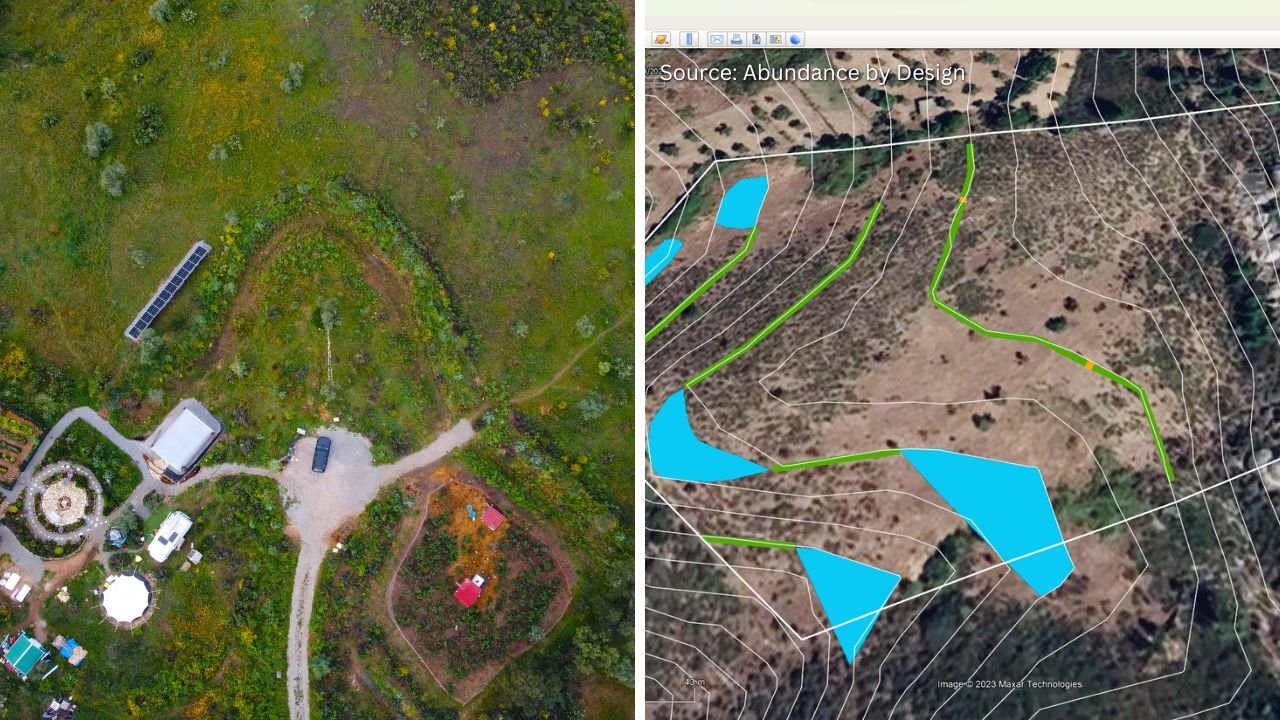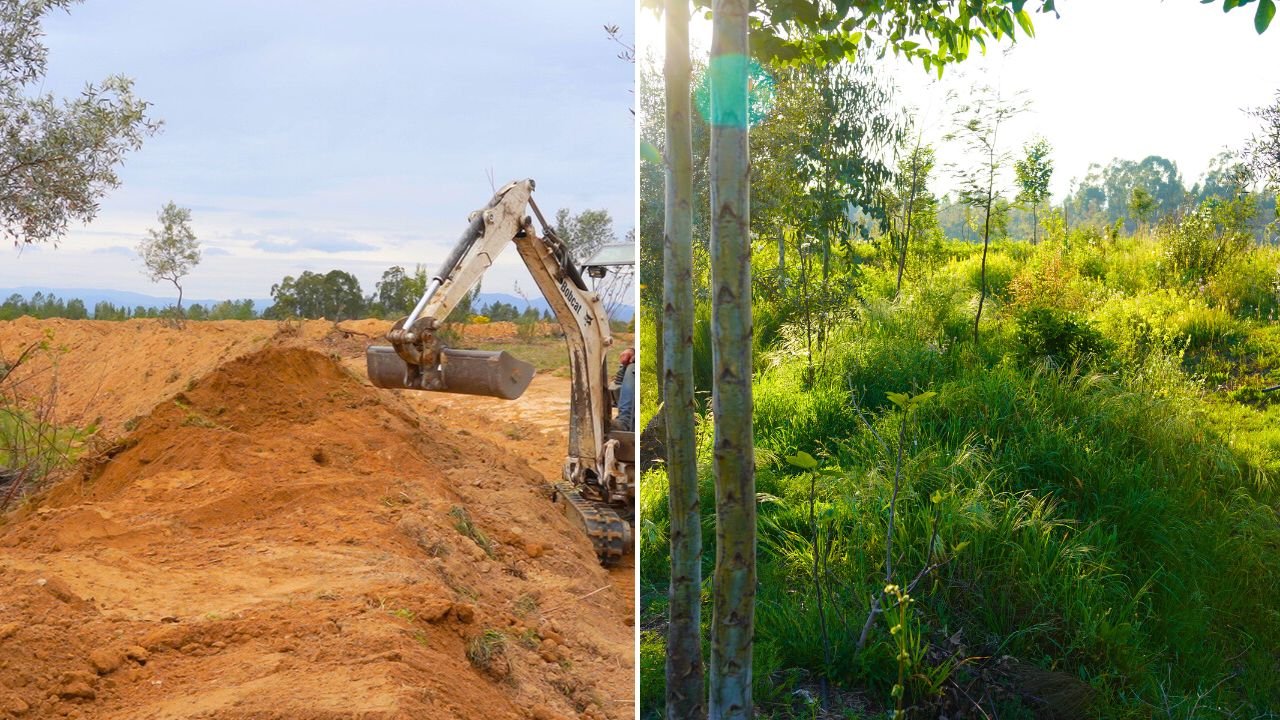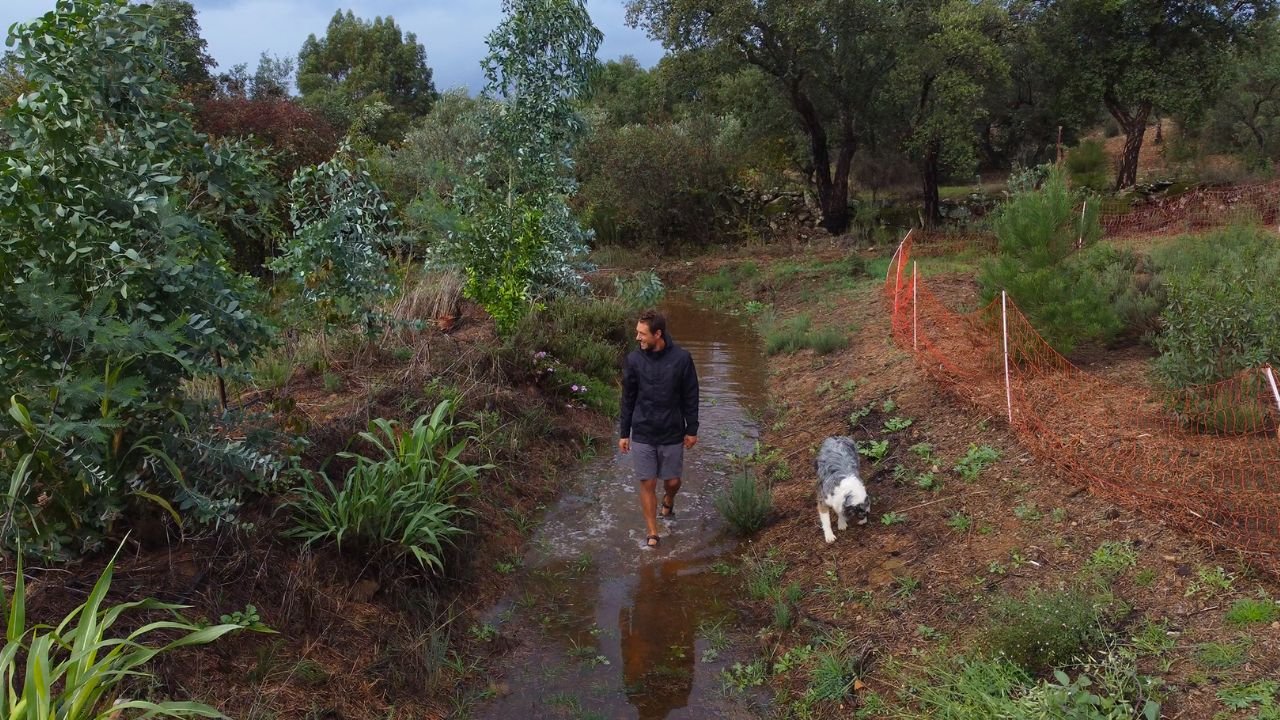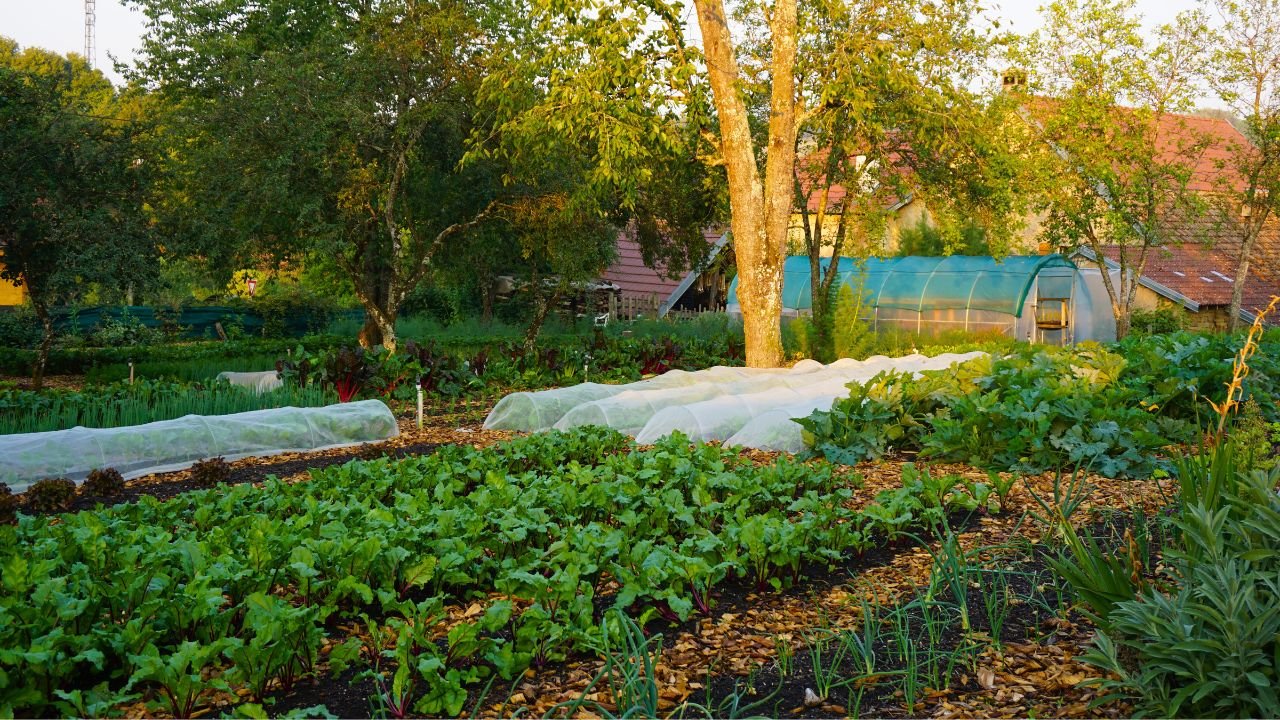Swales 101: Are they the right fit for your land?
Before we headed off to Portugal to start our homestead, we knew dealing with water would be a big deal.
Back in eastern France, where we ran a no-dig market garden for five years, the weather was pretty stable.
We had four predictable seasons, rain came when you expected it, and the temperatures were mild.
It was a good setup.
But moving to pursue our dream of a self-sufficient life in Portugal's warmer climate, we realized things were going to change big time.
The Mediterranean climate meant long, hot, and dry summers that could last a while, and cool, wet winters.
Exposed soil would bake under the sun for months, turning hard like terracotta, only for the winter rains to transform it into mudslides in just a few days.
We've always dreamed of turning a neglected plot into a lush paradise, so naturally, we bought a piece of land that was basically empty.
Very few trees and scattered brittle vegetation.
Why?
I’m still not sure.
Maybe we thought our skills needed a 'hard mode,' or maybe we just love a good challenge.
But that’s a story for another time.
Anyway, if we wanted our homestead to have enough water year-round, we had to figure out how to make the most of those winter rains.
We needed a plan to store that water so that when the hot summer rolled in, our land wouldn’t turn into a desert.
And one option we have for that is the swale.
So, what exactly is a swale?
When I first heard of the concept of a swale in 2015 after watching a documentary about Permaculture, I was a bit confused.
What’s this big deal about swales?
And what are they?
As I dug deeper (pun intended), the concept started to make sense.
A swale is essentially a perfectly level constructed ditch exactly built following the natural contour in a landscape.
(A contour is an imaginary line that runs across a landscape, marking where the height of the land stays the same.)
Left: Birds-eye-view of our main swale. Right: Water-harvesting design of our land - each line is a contour.
Ever noticed how the weather can't seem to make up its mind?
One minute we're desperate for a drop of rain, and the next, there's so much we don't know what to do with it.
That's where swales can come in handy.
Swales are designed to tackle three big problems at once:
Stop the runoff: Usually, rain hits the ground and races off, taking precious topsoil and nutrients with it. Swales put a stop to this, catching the water before it can erode the land.
Redistribute water: They take excess water from wet areas, like valleys, and spread it to the drier parts, like ridges.
Recharge the groundwater: By spreading out the water and letting it soak in slowly, swales help refill the groundwater supply.
It was a solution that made so much sense.
Now, before we continue any further, let's clear up some terminology, because "swale" can mean different things depending on where you are.
In Permaculture (and throughout this article) when we say "swale," we're talking about ditches (and berms) that are built exactly on a contour of the land.
As you can see in the image below:
In some places, especially in the US, people might use "swale" to describe ditches that can be off contour.
These are more about directing water, say, to a specific destination, like a pond, rather than evenly distributing it across the land.
You can think of them as diversion drains or water-harvesting ditches.
It's a subtle difference but an important one.
Anyway, beyond solving those three big water issues (slow, spread, sink), swales have another trick up their sleeve.
They prepare the soil for tree planting.
Left: New main swale being constructed. Right: Same place, 2 years later.
Pretty cool right?
While they're busy saving water and soil, swales also create the perfect conditions for planting trees.
And what does that mean for us?
It’s the first step towards a lush, thriving food forest.
So, from a bit of confusion to a full-on "aha!" moment, swales have become a key part of how we think about working with our land, not just as a way to manage water but as the foundation for our food-producing tree systems.
This naturally begs the question: should everyone build swales everywhere?
Well, not really.
Let me explain.
When to use and when not to use swales?
Swales are basically ditches designed on contour to catch and move rainwater, but they are not a one-size-fits-all solution.
Their effectiveness is influenced by a range of factors.
These include the local climate, the type of soil you’re working with, the lay of the land, and even what’s growing there.
Understanding these different elements is essential to figure out if swales are the way to go for managing water on your land, or if it might be smarter to explore other methods.
That's why doing a basic site assessment and analysis is key (and I've written an article about that right here).
Before we decide where a swale should go we first need to understand if it should go in at all.
Swales are pretty much a long-term commitment to your landscape.
Once they’re installed, moving them isn’t really an option.
And let’s be honest, getting swales right takes a bit more than just enthusiasm.
They require a good amount of planning, resources, skill, and understanding of your land.
In some cases, they help us create a system that works with the natural flow of water and land, sure.
But if they're not designed or built correctly and are placed where they shouldn’t go, they can actually cause more harm than good.
Imagine causing a breakout, where the soil and water decide to create a new path, leading to potential erosion or even damaging floods.
That's the last thing any of us want.
It’s worth weighing the benefits against the investment and risks, especially in landscapes where mistakes can lead to bigger problems down the line.
If you skip assessing your land, you might miss key details about your land's unique characteristics, which can result in decisions that don’t work out as well as you hoped.
So, should you use swales?
To help you answer that question yourself, let me compare our farm in France, with our new homestead in Portugal (and after that, I’ll share with you a useful “checklist” that puts things better into perspective).
Our market garden in France
Now, admittedly, the farm we built in France was on rented land.
So, naturally, you don’t do everything the same as if it were your own property.
Having said that, even if we owned the land, our strategy would have been the same.
On our farm in France, the idea of swales didn't quite fit the overall strategy, goals, and the land.
We were lucky with deep loam soil that felt like a sponge, perfect for holding onto rainwater (and draining it as needed).
Add to that the natural cover provided by trees and always covering the soil with vegetation and mulch, and our land was in a pretty happy place hydration-wise.
Putting in the time, money, and energy to reshape the land with swales just didn’t make sense.
Why fix what isn't broken, right?
This really brings home the point that rehydrating a landscape isn't a one-strategy-fits-all scenario.
In some cases, creating swales can be a solution to help a dry and thirsty land come alive.
In others, as was the case for us in France, a mix of trees, constant ground cover, and a good layer of mulch is all that’s ever needed.
Essentially, your land (together with the vision you have) will guide your design decisions.
That's where the Permaculture principle of "Observe and Interact" comes into play.
Once you get to know your land, you can directly learn from it.
Watch how it behaves across seasons, notice where water flows and where it gathers, and identify the different microclimates.
Often, the best solutions are the simplest ones.
On our farm in France, we noticed the land was already thriving on its own.
By simply using some methods like mulching and always covering the soil with crops, we managed to meet our goals without the need for building any major earthworks.
Our homestead in Portugal
Here in Portugal, the situation is a completely different story.
The ridge on our property lost all its trees to a large forest fire, and then it was clearcut.
This left it prone to erosion.
So, as you can imagine, the heavy winter rains washed away much of the topsoil.
That's why we see so many rocks surfacing on the land.
Typical look of our “soil” on the ridge.
When I was digging holes to plant a food forest next to our road, in many cases, I hit bedrock at just 20 cm (7.9 inches) down in some areas.
Pretty crazy.
Luckily for us, we had a small excavator on-site to help dig the holes for us.
Note the holes dug by the excavator next to the road.
Here, the landscape clearly needed a different strategy.
Increasing the topsoil was a must if we wanted to even consider starting and growing a food forest.
So, essentially, by building swales, we created “raised beds” (berms) and our very own topsoil quickly.
At the same time, the swale's trench helped us collect water better and control erosion.
So, it made sense to turn to swales.
By digging swales, we could gather the rainwater that our land so desperately needed and use the excavated earth to create fertile ground above the rocky base.
One week after digging the swales, mulching, and planting the first trees, we had our first decent rain event.
This way, swales became one of our tools to combat the harsh conditions, allowing us to reintroduce vegetation and begin the healing process of a landscape that needed a little push in the right direction.
With that in mind, here's a checklist I created that could give you a better understanding of whether you should consider swales as a suitable strategy for your land or not.
If you want me to send you a full-sized copy of this checklist, feel free to download it here.
As you can see, swales come with a whole set of considerations.
They're not the best fit for steep, forested terrain.
On such slopes, swales might actually do more harm than good, especially if the soil tends to get waterlogged.
This can lead to soil slump, where the ground literally starts to slide away.
Definitely not what you're aiming for.
And if an area is already forested, 9 out of 10 times, the soil will likely already function like a sponge, and there’s no need for intervening with a system that’s already doing its job.
I personally like to believe that swales are specifically good in regions with dry climates and degraded land that experience occasional heavy rain events.
In these environments, swales do a great job at capturing and redistributing rainwater, helping to prevent runoff and erosion, and ensuring that water sinks into the ground where it's needed most.
2-year-old swale.
But swales are just one of the many tools in our land management toolkit.
In truth, there's a wide range of techniques and strategies available to turn any piece of land into a flourishing ecosystem.
Whether that’s with the help of swales, the use of keyline design, or even through building terraces.
At the end of the day, the full benefit and true potential of any of these strategies is realized when followed up by planting trees, introducing vegetation, and, in some cases, integrating animals into the landscape.
Our first harvest of loquats on our main swale.
Trees and plants play a critical role in restoring the soil, enhancing biodiversity, and creating a balanced ecosystem.
Meanwhile, animals can contribute to soil health through natural grazing patterns, manure, and all the good stuff they do for the land.
It all comes down to choosing the right combination of techniques based on the land's unique characteristics and what you're hoping to accomplish.
Assessing your needs
Before you decide if swales are the right move for your land, take a step back and really think things through.
Every piece of land is different, with its own set of strengths and limitations.
That means what works for one place might not be the best choice for another.
Taking the time to thoroughly assess and plan can make all the difference in your project's success.
And if you want to know how I personally evaluate land to find both the potential and the limitations you might face, I’ve written an entire article that walks you through the process.
Thank you for reading this article.
I hope it was helpful.
Till next time,
Moreno
Whenever you're ready, and if it's the right fit, here are 4 ways I can help you:
1. Join Abundance by Design: Abundance by Design teaches you exactly how to plan, design, and start your homestead in 2 weeks or less using Permaculture. Learn how to achieve a level of self-sufficiency that gives you peace of mind, along with a well-structured plan that lays out the 'do this, then that' to get your homestead up and running smoothly.
2. Year-Round Vegetables - The Garden Planner: Learn how to turn your garden into a year-round grocery store. This course will teach you step-by-step how to create a garden plan for year-round vegetables that are aligned with your climate, food preferences, and garden size.
3. The Reconnected Newsletter: Sign up to receive my free weekly newsletter where I share practical tips to grow your independence & freedom from first seed to self-sufficiency, directly to your inbox.
4. The Homestead Startup Checklist: Download our free, step-by-step checklist you can use to plan, design, and start your homestead from scratch (following our ‘Abundance by Design Framework’).















